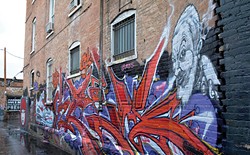When a documentary film about the graffiti artist Banksy was screened during the 2010 Sundance Film Festival, Banksy himself, spray paint can in hand, took a little tour of the mountain town's walls.
The images he left behind have since been shrouded in glass, protected as if they are museum-quality pieces of art work. And in 2014, when a California vandal shattered the protective glass and defaced the Banksy pieces with his own aerosol spray can, the man, David Noll, was promptly charged, prosecuted and fined around $10,000, which was paid to the building owners so they could restore the Banksy paintings.
Few examples of graffiti blurring the line that separates fine art from vandalism are as stark as the Banksy works in Park City, where, rather than being promptly painted over by angry property owners, the pieces have become tourist attractions, proving that not all vandalism is created equal.
But in Salt Lake County, graffiti artists aren't treated quite as saintly as Banksy. On Oct. 27, six graffiti artists were arrested and charged with dozens of felonies related to graffiti vandalism. That a graffiti artist is charged with criminal trespass and vandalism is not unusual, but these most recent arrests represent an unsettling milestone for artists whose work exists in the gray area between art and criminal mischief.
Investigators claim the graffiti artists committed their works of art at the behest of a criminal street gang—a contention that warrants gang-enhanced charges, which increase the severity of fines and, for some of the defendants, could result in decades of prison time.
Salt Lake County District Attorney Sim Gill says that this string of cases, brought forth by a graffiti task force within the West Valley City Police Department, represents the first time that prosecutors have charged graffiti artists with committing crimes for the benefit of a criminal street gang.
Benjamin Wiemeyer, a local mural painter who knows several of the defendants, says that gang charges will bump each allegation up a notch. For instance, a third-degree felony would become a second-degree felony, and a Class A misdemeanor would become a third-degree felony.
"A gang enhancement just seems pretty egregious," Wiemeyer says, noting that, while he understands spray painting private property is against the law, there is a bit of irony in the heavy-handed nature that some crimes are dealt with in society. "Graffiti artists aren't out there just fucking beating people up and extorting people, or having home invasions. They're just fucking painting their names on shit."
Wiemeyer is among the more well-known local graffiti artists, whose work appears on the side of businesses that have hired him to bring life to their walls. One prominent Wiemeyer work is on display on the walls of Gallenson's Gun Shop (166 E. 200 South). On the same block is the Guthrie building, which houses artist studios and Fice Gallery. The brick walls in this pocket of the city explode with aerosol color.
On a Monday afternoon, as Wiemeyer spoke to a news reporter, tourists could be seen snapping photos in front of the murals—some of which were painted by defendants in the vandalism case.
Wiemeyer says painting graffiti represented an important part of his development as an artist, and he suspects the same is true for his friends. The city wouldn't look as vibrant and interesting as it does today without their gifts for commanding spray paint, he says.
"They also have contributed to the graffiti subculture in Salt Lake City by promoting good artwork and keeping the style alive and getting walls," Wiemeyer says. "That's why you see all of the beautiful artwork around Salt Lake on big walls is because of our subculture and our relationships with business owners and moving the subculture that way."
Wiemeyer says another troubling aspect to this recent round of arrests lies in the fact that not one of the suspects was ca,ught in the act.
Gill declined to release any details on the specifics of the case, and West Valley City Police Det. Michael Lynes, who heads up the graffiti task force, declined to comment for this story. Shortly after the arrests, Lynes told ABC 4 that the suspects destroyed property, commited criminal mischief and trespassed. As to the graffiti's artistic merit, or lack thereof, Lynes said much of the artistic side of graffiti has ceased since investigators began cracking down.
However, according to probable-cause statements filed in 3rd District Court, most charges date back at least a year, and some go back as far as 2012. For instance, on Nov. 22, 2012, detectives say two of the defendants painted the inside of a water pipe, causing $500 in damage.
Wiemeyer suspects that the long stretch of time that the charges cover indicates investigators have used social-media accounts to collect evidence. And using social-media accounts, as opposed to catching a graffiti artist in the act, can be problematic, Wiemeyer says, because sometimes a moniker can be used by more than one person.
"You never really know if the person's name that you're seeing, if that person painted it, or if someone else painted it," Wiemeyer says. "So there's a lot of gray area. That's the biggest concern: They weren't caught red-handed; they're building these cases off social media, we suppose."
Gill declined to say how much investigators have relied on social-media accounts to compile evidence in this case, but he says investigators have used social-media accounts before and will continue to do so in the future.
"Evidence is evidence, and law enforcement uses all sorts of techniques to go out and gather that evidence, and social media is one domain of that," Gill says. "We used to shake people's hands and have conversations on sidewalks, and now we have conversations on social media."
In probable-cause statements, investigators maintain that the charges warrant gang enhancements because the graffiti artists "are members of known graffiti/tagger crews and suspects added their graffiti/tagger crew name into the graffiti to further the crew's reputation."
Under Utah statute, this wording is indeed enough to warrant a gang enhancement. In fact, anyone who on a regular basis hangs around with three or more people and does illegal stuff (think smoking marijuana or having a keg party with booze from Wyoming), could be viewed under Utah law as a criminal street gang.
Wiemeyer doesn't believe graffiti artists should be lumped into the same category as gangs that actually hurt people.
And when it comes to assessing the value of art, the discrepancies in Wiemeyer's mind are vast. One man's Picasso, protected under glass in Park City, is, in Salt Lake County, another man's laundry list of felonies.
"That's the hard part, because it is vandalism," Wiemeyer says. "You are damaging property, but there's still a lot of artistic merit in that. I mean, Mount Rushmore: whose property is that? They carved fucking faces into the fucking side of a rock, but no one's getting charged with that."
More by Colby Frazier
-
Fire Line
UFA Board considers recouping bonuses paid to former chiefs and turning investigation over to law enforcement.
- Jan 25, 2017
-
Home Sweet Home?
How a single real estate deal highlights a city in flux and in crisis.
- Jan 4, 2017
-
Dead Red
That Utah could end up voting something other than Republican proved delusional.
- Nov 9, 2016
- More »
Latest in News
Readers also liked…
-
Raise a glass for E.L.T Harrison, architect of the Beerhive building on Main
Small Lake City
- Oct 11, 2023





